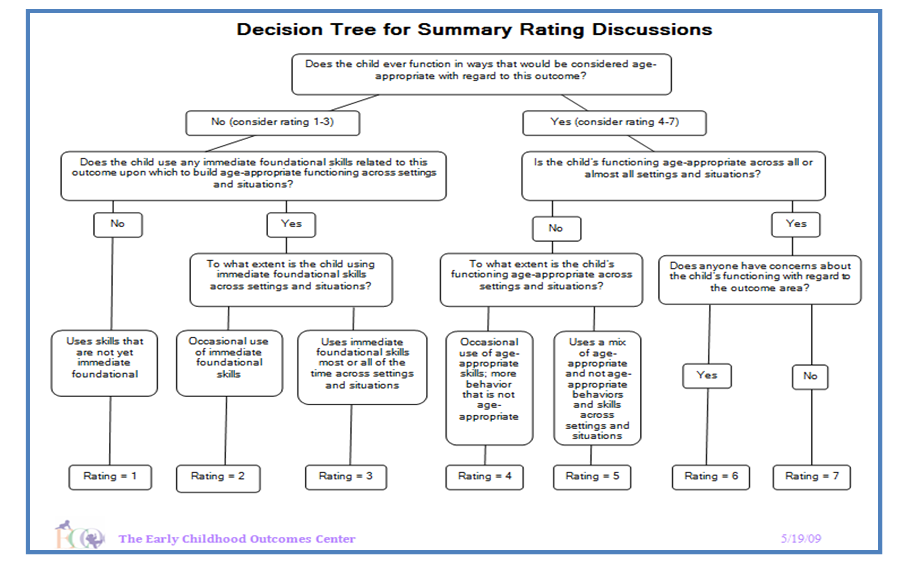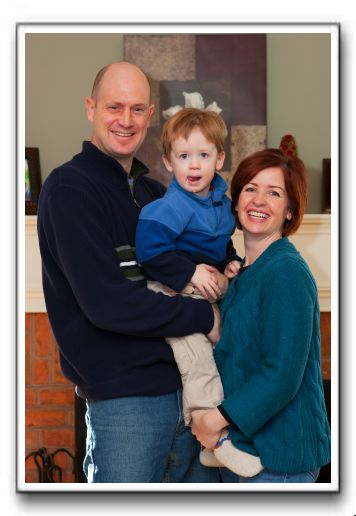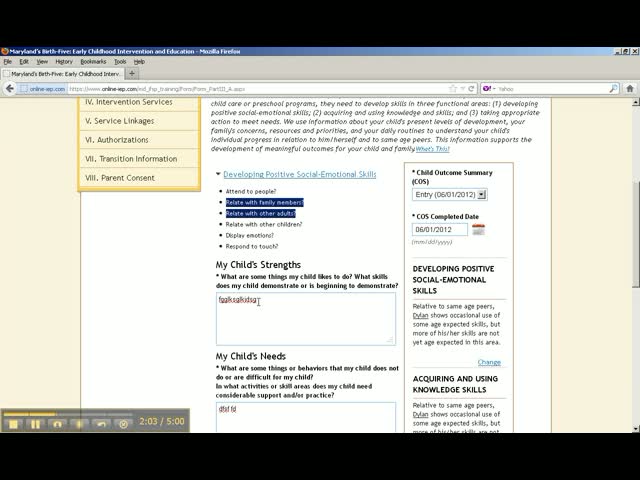Measuring Early Childhood Outcomes Using the COS 7-Point Scale

The COS rating scale ranges from 1 to 7, with a 6 or 7 indicating age-appropriate functioning. Lower numbers indicate further distance from age-appropriateness. The lower the number, the further from age-appropriateness. Another way to think about the ratings is the distribution of age-expected (AE), immediate foundational (IF), and foundational (F) skills a child demonstrates relative to each outcome area. The Maryland COS Descriptors bucket list (shown to the right) illustrates how an IFSP team can sort a child’s skills into these three categories, and then use the definitions of each of the seven points on the scale to assist with determining the applicable rating.
For example, a child that shows:
- Only “F” skills for Outcome #1 would have all skills sorted into the “F” bucket and would have a rating of "1" for that outcome area.
- For Outcome #2, the same child may have some “F” skills and a couple of “IF” skills, and would receive a rating of "2."
- For Outcome #3, he may have mostly “IF” skills and a couple of “AE” skills, and would therefore receive a rating of "4."
COS Rating Decision-Making
The Decision Tree for Summary Rating Discussions is a helpful tool for facilitating COS rating decision-making for each of the three early childhood outcomes. The decision tree, shown below, guides the team through the process via a series of questions. For example, if the team answers "yes" to the first question (i.e., Does the child ever function in ways that would be considered age-appropriate with regard to this outcome?), the discussion proceeds down the right side of the tree. On the contrary, if they answer "no" to that same question, then they would proceed down the left side of the decision tree, and so on.

Using Information Gathered for IFSP Development

In Maryland, the IFSP document (specifically the Strengths and Needs Summary; Part IIIA) is the mechanism for collecting, measuring, and reporting on the three early childhood outcomes. The Strengths and Needs Summary should capture combined information obtained from multiple sources, including:
- the child’s present levels of development (gained through the multidisciplinary evaluation/assessment process, e.g., naturalistic observation, direct assessment, parent interview); and
- a review of the family’s concerns, priorities, resources, and routines in natural environments.
This comprehensive information is used to summarize the child’s strengths and needs in the three early childhood outcome areas. COS ratings are then assigned to indicate the child’s levels of functioning across the three outcome areas in relation to typical development. The COS rating scale was designed to reduce rich information about a child’s functioning into a common metric allowing for a summary of progress across children at the local, State, and national levels. Accordingly, information to complete the COS must involve collecting and synthesizing input from many sources familiar with the child in many different settings and situations. The figure shown below illustrates the concept of taking rich information from a variety of sources, synthesizing the information, and condensing it down into a single rating for each outcome area using the 7-point COS scale.

Clearly, standardized assessment information alone is not sufficient, as a domain score obtained from using an assessment tool does not necessarily translate directly into an outcome rating. Ratings must reflect and convey the child’s current functioning across settings and in situations that make up his/her daily life. A standardized testing situation is unusual for a young child. If the child’s functioning in a testing situation differs from the child’s everyday functioning, the COS rating should reflect the child’s everyday functioning. Furthermore, many assessments are domain-based and were not designed to provide information about functional behaviors across a variety of situations. Knowing that a child has or has not mastered tasks assessed with test items that are related to the outcome provides helpful information, but the information should be used in conjunction with what else is known about the child. A high score on an assessment in a developmental domain based on a set of discrete items related to an outcome area might not mean the child has achieved age-expected skills and, conversely, a low score might not mean the child has not.
Using the COS scale to rate functioning in the outcome areas must be a collaborative decision-making process that draws upon the rich information available from all of the IFSP team members. Keeping a focus on the three broad functional outcomes early on and throughout the IFSP process will facilitate the gathering of information essential to understanding a child’s integrated development and functional skills. Absolutely critical to this process are authentic assessments, parent input, and team involvement.
Summarizing a Child's Strengths and Needs
 In Maryland, the COS is integrated into the Strengths and Needs Summary page (Part IIIA) of the IFSP. The Strengths and Needs Summary page serves two critical purposes:
In Maryland, the COS is integrated into the Strengths and Needs Summary page (Part IIIA) of the IFSP. The Strengths and Needs Summary page serves two critical purposes:
1) To document comprehensive information about a child related to development across the three early childhood outcome areas; and
2) To complete the COS rating process at entry into and at exit from a local Infants and Toddlers Program in the three early childhood outcome areas. (Identifying interim ratings is at the discretion of the local program.)
A strength is what a child enjoys doing and/or a skill a child demonstrates or is beginning to demonstrate. A need is a necessary skill or behavior a child has yet to learn or needs to improve. A need may represent an activity or skill area where a child requires considerable support and/or practice. For each skill/behavior identified as a strength or need, consider the following questions to guide the conversation with the family and to identify the appropriate COS rating descriptor for that early childhood outcome area:
- Are the skills and behaviors demonstrated for this area what one would expect for a child this age? (i.e., age-expected skills)
- If not, are they like those of a younger child? Are they the skills and behaviors that come just before the age-expected skills and behaviors? (i.e., immediate foundational skills)
- If not, are they like those of a MUCH younger child? Are they much earlier than age-expected skills and behaviors or atypical? (i.e., foundational skills)
Click on the image below to view a brief video describing how to complete the Strengths and Needs Summary page (IIIA) in the Online IFSP system.
Collaborative Decision-Making in Action

Refer back to Part 2 of the Engaging Families in the COS Process video for a great example of how to collaboratively involve parents/caregivers in the COS rating decision-making process. Specifically, begin viewing the video at minute 1:20 and focus on how Gretchen, the Special Educator, initiates the COS rating decision-making process with the team.
Strategies for Promoting Collaborative COS Rating Decision-Making

Involving all IFSP team members, including families, in the rating decision is about more than just reading aloud and selecting the associated COS descriptor statement for each of the three outcome areas. We especially want families to understand what the statements mean and how they are linked to the greater initiative of measuring results. We want them to understand how the child’s development relates to his or her same-age peers in each of the three outcome areas. Families can provide rich information about their children’s functioning across settings and situations. It is important to prepare families for the COS discussion. During intake, evaluation/assessment, and IFSP development, it is not only critical to talk about a child’s specific areas of strengths and needs, but to also discuss the importance of understanding where the child is functioning in relation to same-age peers. Prior to the IFSP team meeting, share the worksheet in A Family Guide to Understanding the Individualized Family Service Plan and ask families to record what they feel are the child’s strengths and needs.
By gathering and reviewing well-rounded information with the family about the child’s functioning, the team can make final decisions about the child’s COS ratings collaboratively. Consider the decision-making models below from O'Grady and Jadad (2010). Notice that in collaborative decision-making all team members share their knowledge in a way that allows everyone to expand their understanding and ultimately make decisions. In this light, collaborative decision-making can be regarded as an engaging process that goes beyond one-way knowledge transfer and beyond two-way exchange of knowledge to a shared learning activity where knowledge is blended. Using collaborative decision-making throughout the integrated COS/IFSP process benefits children and families, as well as the professionals involved.

Table developed based on the work of:
O'Grady, L., & Jadad, A. (2010). Shifting from shared to collaborative decision-making: A change in thinking and doing. Journal of Participatory Medicine: Case Studies (Volume 2). Retreived from http://www.jopm.org/evidence/case-studies/2010/11/08/shifting-from-shared-to-collaborative-decision-making-a-change-in-thinking-and-doing-4/


